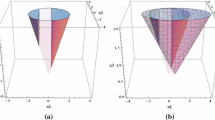Abstract
The duality between facets of the convex hull of disjunctive sets and the extreme points of reverse polars of these sets is utilized to establish simple rules for the derivation of all facet cuts for simple disjunctions, namely, elementary disjunctions in nonnegative variables. These rules generalize the cut generation procedure underlying polyhedral convexity cuts with negative edge extensions. The latter are also shown to possess some interesting properties with respect to a biextremal problem that maximizes the distance, from the origin, of the nearest point feasible to the cut. A computationally inexpensive procedure is given to generate facet cuts for simple disjunctions which are dominant with respect to any specified preemptive ordering of variables.
Similar content being viewed by others
References
E. Balas, “Disjunctive programming: Cutting planes from logical conditions“, in: O.L. Mangasarian, R.R. Meyer, and S.M. Robinson, eds.,Nonlinear programming 2 (Academic Press, New York, 1975) pp. 279–312.
E. Balas, “Disjunctive programming“,Annals of Discrete Mathematics 5 (1979) 3–51.
E. Balas, “Disjunctive programming and a hierarchy of relaxations for discrete optimization problems”, Management Science Research Report MSRR-492, Carnegie-Mellon University (Pittsburgh, PA, 1983).
C.E. Blair and R.G. Jeroslow, “A converse for disjunctive constraints“,Journal of Optimization Theory and Applications 25 (1978) 195–206.
F. Glover, “Polyhedral convexity cuts and negative edge extensions“,Zeitschrift für Operations Research 18 (1974) 181–186.
F. Glover, “Polyhedral annexation in mixed integer and combinatorial programming“,Mathematical Programming 8 (1975) 161–188.
R.G. Jeroslow, “A cutting plane game for facial disjunctive programs“,SIAM Journal on Control and Optimization 18 (1980) 264–281.
G. Owen, “Cutting plane for programs with disjunctive constraints“,Journal of Optimization Theory and Applications 11 (1973) 49–55.
S. Sen and H.D. Sherali, “On the convergence of cutting plane algorithms for a class of nonconvex mathematical programs“,Mathematical Programming 31 (1985) 42–56.
H.D. Sherali and C.M. Shetty, “Deep cuts in disjunctive programming“,Naval Research Logistics Quarterly 27 (1980) 453–475.
H.D. Sherali and C.M. Shetty,Optimization with disjunctive constraints, Lecture Notes in Economics and Mathematical Systems, Volume 181 (Springer-Verlag, Berlin, Heidelberg, New York, 1980).
Author information
Authors and Affiliations
Rights and permissions
About this article
Cite this article
Sen, S., Sherali, H.D. Facet inequalities from simple disjunctions in cutting plane theory. Mathematical Programming 34, 72–83 (1986). https://doi.org/10.1007/BF01582164
Received:
Revised:
Issue Date:
DOI: https://doi.org/10.1007/BF01582164




